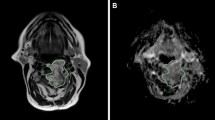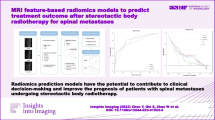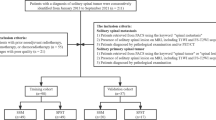Abstract
Objectives
Recently, radiomic analysis has gained attention as a valuable instrument for the management of oncological patients. The aim of the study is to isolate which features of magnetic resonance imaging (MRI)-based radiomic analysis have to be considered the most significant predictors of metastasis in oncological patients with spinal bone marrow metastatic disease.
Materials and methods
Eight oncological patients (3 lung cancer; 1 prostatic cancer; 1 esophageal cancer; 1 nasopharyngeal cancer; 1 hepatocarcinoma; 1 breast cancer) with pre-radiotherapy MR imaging for a total of 58 dorsal vertebral bodies, 29 metastatic and 29 non-metastatic were included. Each vertebral body was contoured in T1 and T2 weighted images at a radiotherapy delineation console. The obtained data were transferred to an automated data extraction system for morphological, statistical and textural analysis. Eighty-nine features for each lesion in both T1 and T2 images were computed as the median of by-slice values. A Wilcoxon test was applied to the 89 features and the most statistically significant of them underwent to a stepwise feature selection, to find the best performing predictors of metastasis in a logistic regression model. An internal cross-validation via bootstrap was conducted for estimating the model performance in terms of the area under the curve (AUC) of the receiver operating characteristic.
Results
Of the 89 textural features tested, 16 were found to differ with statistical significance in the metastatic vs non-metastatic group. The best performing model was constituted by two predictors for T1 and T2 images, namely one morphological feature (center of mass shift) (p value < 0.01) for both datasets and one histogram feature minimum grey level (p value < 0.01) for T1 images and one textural feature (grey-level co-occurrence matrix joint variance (p value < 0.01) for T2 images. The internal cross-validation showed an AUC of 0.8141 (95% CI 0.6854–0.9427) in T1 images and 0.9116 (95% CI 0.8294–0.9937) in T2 images.
Conclusions
The results suggest that MRI-based radiomic analysis on oncological patients with bone marrow metastatic disease is able to differentiate between metastatic and non-metastatic vertebral bodies. The most significant predictors of metastasis were found to be based on T2 sequence and were one morphological and one textural feature.




Similar content being viewed by others
References
Coleman RE (2001) Metastatic bone disease: clinical features, pathophysiology and treatment strategies. Cancer Treat Rev 27(3):165–176
Coleman RE (2006) Clinical features of metastatic bone disease and risk of skeletal morbidity. Clin Cancer Res 12(20 Pt 2):6243s–6249s
Kumar V, Gu Y, Basu S et al (2012) Radiomics: the process and the challenges. Magn Reson Imaging 30(9):1234–1248
Lambin P, Rios-Velazquez E, Leijenaar R et al (2012) Radiomics: extracting more information from medical images using advanced feature analysis. Eur J Cancer 48(4):441–446
Ravanelli M, Farina D, Morassi M, Roca E, Cavalleri G, Tassi G, Maroldi R (2013) Texture analysis of advanced non-small cell lung cancer (nsclc) on contrast-enhanced computed tomography: prediction of the response to the first-line chemotherapy. Eur Radiol 23(12):3450–3455
Bayanati H, Thornhill RE, Souza CA, Sethi-Virmani V, Gupta A, Maziak D, Amjadi K, Dennie C (2015) Quantitative CT texture and shape analysis: can it differentiate benign and malignant mediastinal lymph nodes in patients with primary lung cancer? Eur Radiol 25(2):480–487
Ma W, Ji Y, Qi L, Guo X, Jian X, Liu P (2018) Breast cancer Ki67 expression prediction by DCE-MRI radiomics features. Clin Radiol S0009–9260(18):30220–30224
Abdollahi H, Mahdavi SR, Mofid B, Bakhshandeh M, Razzaghdoust A, Sadipour A, Tanha K (2018) Rectal wall MRI radiomics in prostate cancer patients: prediction of and correlation with early rectal toxicity. Int J Radiat Biol 3:1–36
Jethanandani A, Lin TA, Volpe S, Elhalawani H, Mohamed ASR, Yang P, Fuller CD (2018) Exploring applications of radiomics in magnetic resonance imaging of head and neck cancer: a systematic review. Front Oncol 8:131
Hou Z, Li S, Ren W, Liu J, Yan J, Wan S (2018) Radiomic analysis in T2W and SPAIR T2W MRI: predict treatment response to chemoradiotherapy in esophageal squamous cell carcinoma. J Thorac Dis 10(4):2256–2267
Pinker K, Chin J, Melsaether AN, Morris EA, Moy L (2018) Precision medicine and radiogenomics in breast cancer: new approaches toward diagnosis and treatment. Radiology 287(3):732–747
Hou Z, Ren W, Li S, Liu J, Sun Y, Yan J, Wan S (2017) Radiomic analysis in contrast-enhanced CT: predict treatment response to chemoradiotherapy in esophageal carcinoma. Oncotarget 8(61):104444–104454
Vanel D, Dromain C, Tardivon A (2000) MRI of bone marrow disorders. Eur Radiol 10:224–229
Romanos O, Solomou E, Georgiadis P, Kardamakis D, Siablis D (2013) Magnetic resonance imaging and image analysis of post—radiation changes of bone marrow in patients with skeletal metastases. J BUON 18(3):788–794
Alyas F, Saifuddin A, Connell D (2007) MR imaging evaluation of the bone marrow and marrow infiltrative disorders of the lumbar spine. Magn Reson Imaging Clin N Am 15:199–219
Schweitzer ME, Levine C, Mitchell DG, Gannon FH, Gomella LG (1993) Bull’s-eyes and halos: useful MR discriminators of osseous metastases. Radiology 188:249–252
Kumar V, Gu Y, Basu S, Berglund A et al (2012) Radiomics: the process and the challenges. Magn Reson Imaging 30(9):1234–1248
R Core Team (2017). R: A language and environment for statistical computing. R Foundation for Statistical Computing, Vienna, Austria. https://www.R-project.org/
Broersen P (2000) Finite sample criteria for autoregressive order selection. IEEE Trans Signal Process 48(12):3550–3558
Priestley M (1981) Spectral analysis and time series. Volume 1: univariate series. Academic Press, Cambridge
Dinapoli N, Alitto AR, Vallati M, Gatta R, Autorino R, Boldrini L, Damiani A, Valentini V (2015) Moddicom: a complete and easily accessible library for prognostic evaluations relying on image features. Conf Proc IEEE Eng Med Biol Soc 2015:771–774
Acknowledgements
The authors would like to thank Roberto Gatta (Department of Radiation Oncology—Gemelli-ART, Catholic University of Rome, School of Medicine, Foundation University Hospital “A. Gemelli”) for the experienced support during data analysis.
Author information
Authors and Affiliations
Corresponding author
Ethics declarations
Conflict of interests
All the authors declare they do not have conflict of interests.
Ethical approval
All procedures performed in studies involving human participants were in accordance with the ethical standards of the institutional and/or national research committee and with the 1964 Helsinki Declaration and its later amendments or comparable ethical standards.
Rights and permissions
About this article
Cite this article
Filograna, L., Lenkowicz, J., Cellini, F. et al. Identification of the most significant magnetic resonance imaging (MRI) radiomic features in oncological patients with vertebral bone marrow metastatic disease: a feasibility study. Radiol med 124, 50–57 (2019). https://doi.org/10.1007/s11547-018-0935-y
Received:
Accepted:
Published:
Issue Date:
DOI: https://doi.org/10.1007/s11547-018-0935-y




